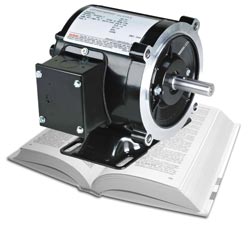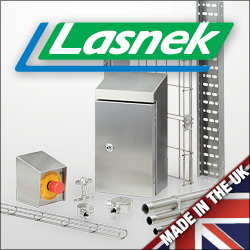
Posted to News on 19th Feb 2014, 22:38
Glossary of terms: permanent magnet motors
This glossary of terms relating to permanent-magnet electric motor technology has been compiled by Bill Bertram, Managing Director of REGAL C&I Europe.

Alignment torque: is produced by the interaction of the magnetic fields produced by permanent magnets and winding currents, also called mutual torque.
Axial flux: the magnetic field that travels in an axial direction across the air gap between the rotor and stator.
BLAC motor: a Brushless AC electric motor, also known as a permanent magnet synchronous motor (PMSM), is similar to a brushless DC (BLDC) electric motor in that the magnetic field of the rotor is supplied by the permanent magnets rather than by electromagnets. However, the stator windings of brushless AC motors are sinusoidally distributed windings, while those of a brushless DC motor are salient field coils.
BLDC motor: a Brushless DC motor is a synchronous electric motor powered by direct current (DC) and having an electronic commutation system, rather than a mechanical commutator and brushes. The BLDC motor is described in terms such as torque constant and back EMF constant. In BLDC motors, current to torque and voltage torque are linear relationships.
Back EMF (BEMF): the voltage generated when a permanent magnet motor is rotated. This is proportional to motor speed and is present regardless of whether the motor winding(s) are energised or unenergised.
Closed loop: is a broadly applied term, relating to any system in which the output is measured and compared to the input. The output is then adjusted to reach the desired condition. In motion control, the term typically describes a system utilising a velocity and/or position transducer to generate correction signals in relation to desired parameters.
Cogging (cogging torque): a term used to describe non-uniform angular velocity. Cogging appears as jerkiness, especially at low speeds.
Commutation: the process of energising and de-energising motor phase windings in a way that produces useful torque.
Concentrated windings: windings that are physically isolated from other phase windings.
Core: a shaped structure of ferromagnetic material which conducts magnetic flux.
Core losses: are combined hysteresis and eddy current losses in a material.
Curie temperature: or Curie Point refers to a characteristic property of a ferromagnetic or piezoelectric material.
Demagnetization current: the current level at which the motor magnets will start to demagnetise. This is an irreversible effect, which will alter the motor characteristics and degrade performance. Also known as peak current.
Detent position: rotor position where there is zero torque.
Direct Drive technology: motors that transmit power to the application directly without gears, pulleys, chains or belts.
Distributed windings: are distributed and interlaced with other phase windings to simulate a sinusoidal wave.
Down Framing: the ability to increase the motor's power in a smaller frame size.
Dynamic braking: a passive technique for stopping a motor. The windings are shorted together through a resistor.
Electrically commutated motor (ECM): is a brushless motor, which relies on the external power drive to perform the commutation of stationary copper winding on the stator. This changing stator field drives the permanent magnet rotor.
Eddy current: localised currents induced in an iron core by alternating magnetic flux. These translate into losses (heat).
Efficiency (motor): the ratio of mechanical output to electrical input, ie the effectiveness with which the motor converts electrical energy into mechanical energy.
Efficiency (system): the overall efficiency of the motor, controls, electric cables, drive train and driven equipment. This is determined by multiplying the individual component efficiencies together.
Encoder: a feedback device which converts mechanical motion into electronic signals. An encoder may consist of a wheel with, typically, 1000 alternating transparent and opaque stripes, detected by optical sensors to produce the digital outputs.
Ferrites: chemical compounds, ceramic with iron(III)oxide Fe2O3, as their principal components. Many of them are magnetic materials.
Field weakening: a term used in vector control whereby the motor currents must be increased before the respective peaks of the back EMF appear. This is done by advancing the motor currents in phase relative to their back EMF.
Flux density: the density of the magnetic field at a point in space.
Hall-effect sensor: a feedback device used in a brushless system to provide information for the amplifier to electronically commutate the motor.
Hysteresis: a reverberation-like property of a magnetic material which can produce energy loss.
Inductance: resistance in an electrical circuit which opposes the change in current.
Inertia: an object's resistance to change in velocity.
Inertial match: for efficient operation, the inertia of the load should equal the rotor inertia of the motor.
Inside-out motor: a motor where the stator is inside the rotor.
Interior permanent magnet (IPM): the permanent magnets are buried within the steel structure. This allows the use of flux concentration, improves structural strength, allows higher speeds and widens speed range through field weakening control.
Magnetic anisotropy: the direction dependence of a material's magnetic properties. A magnetically isotropic material has no preferential direction for its magnetic moment in zero field, while a magnetically anisotropic material will align its moment to an easy axis.
Magnetomotive force (MMF): any physical force that produces magnetic flux.
Magnetic flux: a measure of quantity of magnetism, taking into account the strength and the extent of a magnetic field.
Magnetic saliency: the variation of the inductance at the motor terminal according to the rotor position. Also referred to as inductance saliency.
MAX GUARD: an insulation system that combines corona-resistant magnet wire with a patented 'low stress' winding configuration.
Mutual torque: see alignment torque.
Neodymium magnet: currently the strongest type of permanent magnet.
Pancake motor: an axial flux motor having radially directed windings.
Peak torque: the maximum torque which a PM motor can deliver for short periods of time.
Permeability: describes how easily a magnetic field flows through a material.
Permanent magnet synchronous motor (PMSM): is an AC motor distinguished by a rotor spinning with coils passing magnets at the same rate as the alternating current and resulting magnetic field which drives it. Also referred to as brushless AC and permanent magnet AC.
Power: the rate at which work is done, equal to torque multiplied by speed.
Power density: the power to weight ratio of a motor.
Radial flux: the magnetic field that travels radially across the air gap between the rotor and stator.
Reluctance (magnetic): analogous to resistance in an electrical circuit, but rather than dissipating energy, it stores magnetic energy.
Reluctance torque: produced by either permanent magnets or winding currents acting alone.
Repeatability: the degree to which a parameter such as position or velocity can be duplicated.
Resolver: an electromagnetic feedback device which converts angular shaft position into analogue signals.
Root mean square (RMS) torque: in an intermittent duty cycle application, the RMS torque is equal to the value of steady state torque which would produce the equivalent motor heating.
Saturation: non-linear property whereby it becomes increasingly difficult to force additional magnetic flux through a material.
Shaft torque: the amount of torque developed with voltage applied and shaft locked, or not rotating. Also known as locked rotor torque.
Skew: the arrangement of laminations or magnets on a rotor to provide a slight diagonal pattern of their slots.
Stiffness: the ability to resist movement induced by an applied torque.
Torque: an angular force which produces rotational motion.
Torque-to-inertia ratio: a motor's holding torque divided by the inertia of its rotor. The higher the ratio, the higher the maximum acceleration.
Torque constant: the rate at which torque increases with respect to current.
Trapezoidal waveform: when the back EMF is trapezoidal, the motor is referred to as a brushless DC Motor.
Ultra Efficient: a level of efficiency substantially higher than NEMA Premium, meets IE4.
Vector control: a highly accurate means of closed-loop motor control.
Velocity: speed and direction.
For downloads, datasheets and product information relating to permanent-magnet motors, go to www.rotor.co.uk.
Unit 8, 16 Everitt Close
Denington Industrial Estate
NN8 2QF
UNITED KINGDOM
+44 (0)1933 230900


















